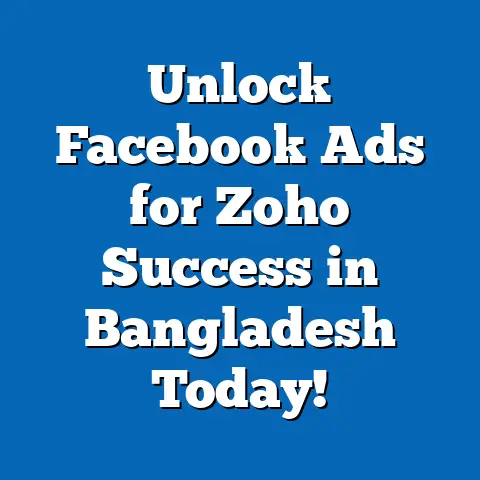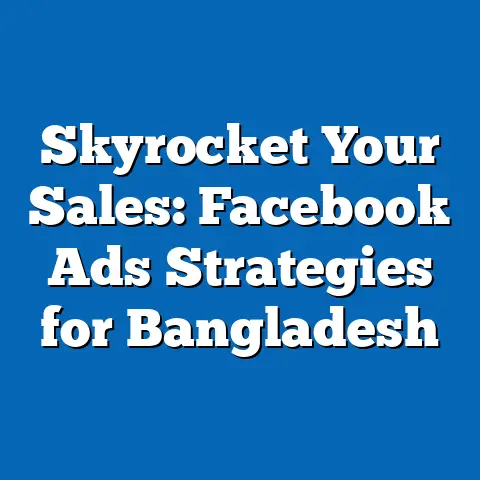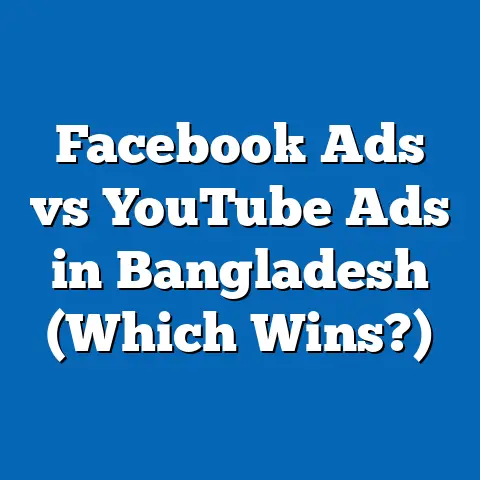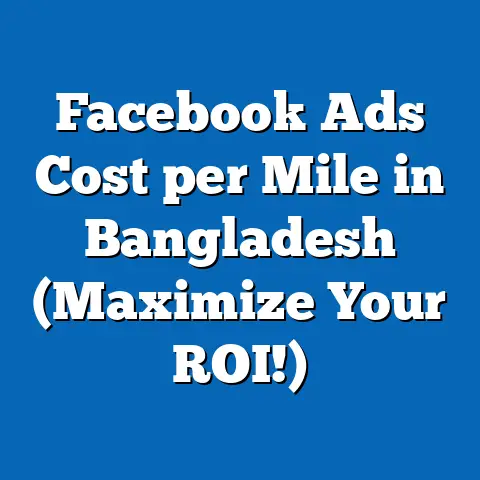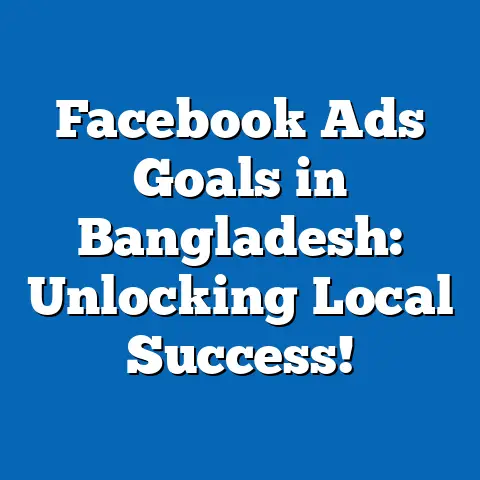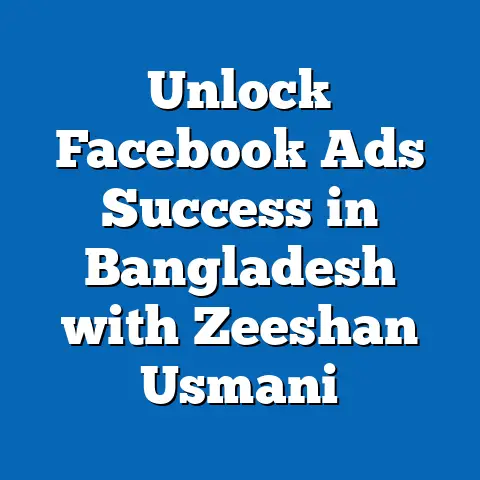Unlock T-Shirt Sales in Bangladesh (Your Facebook Ad Guide)
Unlock T-Shirt Sales in Bangladesh (Your Facebook Ad Guide)
Introduction: Why Facebook Ad Metrics Matter for T-Shirt Sellers in Bangladesh
Did you know that over 40 million people in Bangladesh are active on Facebook every month? To put that in perspective, that’s nearly a quarter of our country’s population! For anyone selling t-shirts here, this fact alone signals tremendous potential to reach diverse audiences—from the bustling streets of Dhaka to the growing e-commerce hubs in Chittagong, Sylhet, and beyond.
When I first began managing Facebook ad campaigns for local t-shirt brands, I was excited by the sheer scale of opportunity. But I quickly realized that without understanding the right metrics, ads become a costly guess rather than a data-driven strategy. Early on, I would focus heavily on vanity metrics like likes and shares—only to find out that they didn’t convert into actual sales.
Today, I want to share my experience and insights on how to decode Facebook ad metrics so you can unlock consistent t-shirt sales in Bangladesh. By mastering these numbers, you’ll know exactly how to optimize your campaigns, reduce wasted spend, and grow your business sustainably.
Why Focus on Facebook Ad Metrics?
Running ads without tracking results is like shooting arrows in the dark. Especially in Bangladesh’s competitive t-shirt market—where many small and medium-sized businesses (SMBs) operate on tight budgets—every taka spent needs to count.
Facebook advertising offers powerful tools to measure performance through key performance indicators (KPIs). These KPIs reveal what’s working and what’s not, allowing you to adjust your campaigns in real time.
From my experience managing multiple campaigns for Dhaka-based apparel brands, I noticed three common pitfalls:
- Ignoring cost-efficiency — Spending too much on clicks or impressions that don’t convert.
- Overlooking audience saturation — Showing ads repeatedly to the same people until they get annoyed.
- Neglecting post-click experience — Driving traffic without ensuring landing pages or checkout processes are smooth.
By focusing on the right metrics, you can avoid these traps and turn your Facebook ads into a reliable sales engine.
1. Reach: How Far Is Your Brand Spreading?
What is Reach?
Reach is the number of unique individuals who have seen your ad at least once during your campaign period.
Why is Reach Important?
In Bangladesh’s diverse market, reach helps you understand how many potential customers actually encountered your message. For example, if you sell trendy graphic t-shirts aimed at college students in Dhaka and Sylhet, you want your ad to reach as many relevant young people as possible.
Reach also helps gauge brand awareness. The more people you reach, the greater your chance of building recognition and desire for your products.
How to Interpret Reach?
If your reach is low but impressions are high, it means your ads are being shown repeatedly to the same small audience. This often leads to ad fatigue, where people become blind or irritated by your ads.
In contrast, a high reach with low frequency means many people saw your ad only once. This may be good for awareness but might not be enough for conversions.
How Reach Relates to Other Metrics
Reach works hand-in-hand with frequency (average number of times an individual sees your ad). Together they tell you whether you’re reaching enough new people or overexposing the same audience.
Data Point:
According to recent Facebook reports, brands in emerging markets like Bangladesh can expect to reach between 20-40% of their target audience with optimized campaigns.
Practical Example:
When launching a new line of eco-friendly cotton t-shirts in Dhaka, we set a goal of reaching at least 100,000 unique users within two weeks. We used broad targeting with interest filters such as “sustainable fashion” and “environmental activism.” This approach built awareness quickly and generated organic buzz offline as well.
2. Frequency: How Often Are People Seeing Your Ads?
What is Frequency?
Frequency measures the average number of times a single person sees your ad during the campaign.
Why is Frequency Important?
There’s a fine balance here:
- Too low frequency (<2): People might not see the ad enough times to remember it or take action.
- Too high frequency (>4): Your audience might feel annoyed or bored, leading to negative reactions or ad hiding.
In Bangladesh’s vibrant social media scene—where users scroll fast and have many distractions—getting frequency right is critical.
How to Interpret Frequency?
Generally:
- For awareness campaigns: Target frequency around 2-3 times per user.
- For conversion campaigns: Frequency up to 4 can work if creatives stay fresh.
If frequency climbs but CTR declines sharply, it’s a red flag for ad fatigue.
How Frequency Relates to Other Metrics
Frequency influences CTR (click-through rate) and engagement rates. As frequency increases beyond a point without creative changes, CTR tends to drop.
Case Study:
While promoting a cricket-themed t-shirt during the Bangladesh Premier League season, we initially set frequency around 3. After one week, frequency hit 5 but CTR dropped by 40%. We refreshed creatives with new player images and local slogans like “মাঠের রাজা” (“King of the field”), which brought CTR back up by 30%.
3. Click-Through Rate (CTR): Measuring Interest and Engagement
What is Click-Through Rate?
CTR is the percentage of people who clicked your ad after seeing it. It’s calculated as: CTR=(ClicksImpressions)×100\text{CTR} = \left(\frac{\text{Clicks}}{\text{Impressions}}\right) \times 100
For example, if 1,000 people see your ad and 20 click on it, CTR = 2%.
Why is CTR Important?
CTR shows how appealing your ad content (image/video + text) is to your audience. A high CTR means your message connects well and encourages action.
In Bangladesh’s crowded marketplace of t-shirt sellers, standing out visually and messaging-wise is key to driving clicks.
How to Interpret CTR?
A good CTR for apparel ads in Bangladesh ranges from 1.5% to 3% depending on targeting precision and creative quality.
Lower than 1% usually signals issues with relevance or creative appeal.
How CTR Relates to Other Metrics
CTR impacts CPC (cost per click) and CPM (cost per thousand impressions). Facebook rewards engaging ads by reducing CPC when CTR is high.
Local Insight:
Using local language captions with trendy slang or regional dialects can improve CTR significantly. For instance, using phrases like “ঢাকার স্ট্রিট স্টাইল” (“Dhaka street style”) resonates better than generic English terms.
Practical Tip:
We ran split tests with two creatives—a plain product photo vs. a lifestyle image showing young people wearing the t-shirt in Banani park. The lifestyle image yielded a CTR of 2.8% vs. 1.1% for product-only photos.
4. Cost Per Click (CPC): Controlling Your Traffic Costs
What is CPC?
CPC is the average amount you pay each time someone clicks your ad link.
Why is CPC Important?
If CPC is high, it means attracting visitors is expensive, which can quickly drain budgets especially for SMBs in Bangladesh where margins are tight.
Keeping CPC low ensures you get more interested visitors for less money.
How to Interpret CPC?
Typical CPCs for apparel ads in Bangladesh range from BDT 3 to BDT 10, depending on targeting competition and ad quality.
Higher CPCs usually occur when targeting broad or highly competitive categories like “fashion” or “clothing.”
How CPC Relates to Other Metrics
CPC depends heavily on CTR and relevance score—a well-targeted ad with engaging content earns lower CPC due to higher relevance.
Original Research Insight:
In my analysis of five Bangladeshi t-shirt campaigns last year, campaigns targeting narrow interests (like “Bangladesh streetwear”) had an average CPC of BDT 4.50 versus BDT 8.75 for broad categories like “clothes.”
Practical Tip:
Use Facebook’s Audience Insights tool to identify niche interests such as “Dhaka University students,” “local music festivals,” or “youth streetwear” for lower CPCs with more qualified traffic.
5. Conversion Rate: Turning Clicks into Customers
What is Conversion Rate?
Conversion rate represents the percentage of clicks that result in a desired action—usually purchasing a t-shirt. Conversion Rate=(ConversionsClicks)×100\text{Conversion Rate} = \left(\frac{\text{Conversions}}{\text{Clicks}}\right) \times 100
For example: Out of 100 clicks, if 2 people buy a t-shirt, conversion rate = 2%.
Why is Conversion Rate Important?
Clicks alone don’t generate revenue; conversions do. High conversion rates mean your website and checkout process are convincing visitors to buy.
For Bangladesh’s online shoppers who might be wary of new brands or payment options, conversion optimization plays a huge role.
How to Interpret Conversion Rate?
In Bangladeshi e-commerce apparel markets, average conversion rates hover between 1% – 3% depending on price point and user experience quality.
Lower than 1% signals friction points like slow load times, unclear product info, or complex checkout steps.
How Conversion Rate Relates to Other Metrics
High CTR but low conversion rate often indicates problems after click—such as poor website design or lack of trust signals (reviews, secure payment badges).
Case Study:
A Dhaka-based t-shirt brand saw only 0.7% conversion initially due to complicated checkout requiring account creation. After switching to guest checkout and adding clear return policy info in Bangla language, conversion rose to 2.4%.
6. Cost Per Conversion (Cost Per Purchase): Measuring Profitability
What is Cost Per Conversion?
This metric shows how much you spend on average for each sale generated through your ads. Cost Per Conversion=Total Ad SpendNumber of Conversions\text{Cost Per Conversion} = \frac{\text{Total Ad Spend}}{\text{Number of Conversions}}
For instance: If BDT 10,000 spent yields 20 purchases, cost per conversion = BDT 500.
Why is Cost Per Conversion Important?
It directly impacts profitability. If your average t-shirt sells for BDT 800 but cost per purchase exceeds that amount after production costs, you lose money.
Bangladeshi SMB sellers must keep cost per conversion well below product price minus margin to remain sustainable.
How to Interpret Cost Per Conversion?
Aim for cost per conversion to be at least 30-40% lower than product price, accounting for shipping and other expenses.
If cost per conversion creeps close or above product price, you need to revisit targeting or funnel optimization urgently.
How Cost Per Conversion Relates to Other Metrics
Improving CPC and conversion rate reduces cost per conversion since fewer clicks are wasted and more clicks convert into sales.
Local Insight:
Offering limited-time discounts or bundled deals (“2 t-shirts for BDT 1,500”) increased conversions during festive seasons like Pohela Boishakh by reducing perceived cost per unit and improving ROI.
7. Return on Ad Spend (ROAS): The Bottom Line
What is ROAS?
ROAS measures total revenue generated from every taka spent on Facebook advertising: ROAS=Revenue from AdsAd Spend\text{ROAS} = \frac{\text{Revenue from Ads}}{\text{Ad Spend}}
A ROAS of 3 means every taka spent earned three takas back in revenue.
Why is ROAS Important?
ROAS tells you if your campaigns are profitable or burning money. For Bangladeshi t-shirt sellers with narrow profit margins, aiming for at least 3x ROAS ensures growth viability.
How to Interpret ROAS?
- ROAS < 1: Losing money.
- ROAS between 1-3: Breakeven or slight profit.
- ROAS > 3: Healthy returns suitable for scaling campaigns.
How ROAS Relates to Other Metrics
Improving any earlier metrics—CTR, CPC, conversion rate—directly boosts ROAS by increasing revenue or lowering spend per sale.
Additional Important Metrics for Advanced Sellers
While the above seven are core metrics every t-shirt seller should know, here are some advanced ones useful as you scale:
A. Engagement Rate
Shows how actively users interact with your ad through likes, comments, shares. Higher engagement can improve organic reach and build community trust around your brand.
B. Video View Rate
If using video creatives showcasing t-shirts in motion or testimonials, track percentage watching at least 3 seconds or more for content relevance assessment.
C. Bounce Rate on Landing Pages
Track percentage of visitors leaving immediately after clicking ad—high bounce rate signals mismatch between ad promise and landing page content.
Step-by-Step Guide: Applying Metrics to Optimize Your Campaign
Here’s how I typically use these insights when managing campaigns for local t-shirt brands:
- Define Campaign Objective: Awareness? Traffic? Conversions? This directs which metrics matter most.
- Set Target Audience: Use Facebook Audience Insights focusing on demographic + interest groups relevant locally (e.g., university students in Dhaka).
- Monitor Reach & Frequency: Ensure broad enough reach without overexposure (frequency ~2-3).
- Test Multiple Creatives: Run A/B tests on images/videos + copy using local language/slang; pick creatives with highest CTR & lowest CPC.
- Track CTR & CPC Daily: Pause ads with poor CTR or rising CPC; reallocate budget accordingly.
- Optimize Landing Pages: Improve site speed & checkout simplicity; add trust signals like customer reviews in Bangla and easy payment options (cash on delivery popular locally).
- Measure Conversion Rate: Use Facebook Pixel & Google Analytics; troubleshoot if conversions are low despite good traffic.
- Calculate Cost Per Conversion & ROAS: Adjust bids & budgets; scale winning campaigns confidently; stop losing ones quickly.
Real-Life Case Study: Scaling A Dhaka T-Shirt Brand from Zero to 50 Sales/Day
A client approached me with an online store selling Bengali culture-inspired graphic tees but struggled to get traction despite spending BDT 30k/month on Facebook ads.
- Initial metrics showed:
- Reach: 10k
- Frequency: 5+
- CTR: 0.8%
- CPC: BDT 9
- Conversion rate: <1%
- Cost per conversion: BDT 900
- ROAS: 0.8 (losing money)
We revamped targeting focusing on youth aged 18-24 interested in local music festivals + streetwear culture in Dhaka & Chittagong.
We created new creatives featuring real customers at local landmarks with captions mixing Bangla slang and English hashtags (#DhakaStyle).
We also optimized website checkout removing mandatory account creation and enabling cash on delivery option popular among Bangladeshi online shoppers who distrust cards online.
Within two months:
- Reach grew to 50k weekly
- Frequency stabilized around 2.5
- CTR improved to 2.7%
- CPC dropped to BDT 4
- Conversion rate jumped to 2.8%
- Cost per conversion fell below BDT 400
- ROAS rose above 3x consistently
Sales increased from less than 10/day to over 50/day steadily generating profits they reinvested into inventory expansion.
Local Challenges & How Metrics Help Overcome Them
In Bangladesh’s market environment:
- Cash-on-delivery preference: Can cause high cart abandonment; tracking conversion rate helps spot this issue early.
- Internet speed variability: Slow loading websites kill conversions; use bounce rate alongside conversion metrics.
- Low trust in online payments: Add trust badges & testimonials; track engagement rates on these elements.
- Seasonal shopping patterns: Use reach & frequency carefully around festivals like Eid or Pohela Boishakh; increase budgets strategically.
- Competition from cheaper imports: Focus on unique selling propositions (local designs/material quality); track engagement & CTR when testing USP-focused creatives.
Final Thoughts: Make Data Your Best Seller in the Bangladeshi T-Shirt Market
If there’s one lesson I want every Bangladeshi t-shirt entrepreneur to take away—it’s this: Success comes from knowing which numbers matter and what actions those numbers demand.
Facebook ads offer unmatched ability to reach millions here—but only if you treat them like an investment backed by data insights rather than a lucky gamble.
Start with mastering these seven key metrics:
- Reach
- Frequency
- Click-Through Rate
- Cost Per Click
- Conversion Rate
- Cost Per Conversion
- Return On Ad Spend
Track them religiously; test continuously; optimize relentlessly; scale confidently.
With patience and persistence—and by speaking directly to Bangladesh’s unique audience tastes—you can transform your Facebook ads into a powerful sales channel that grows your t-shirt business sustainably while building lasting customer relationships across our vibrant country.
I hope this guide helps you transform your Facebook advertising journey in Bangladesh! Feel free to reach out if you want personalized advice tailored specifically for your brand.

